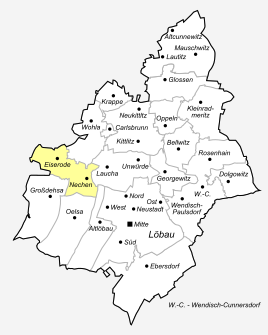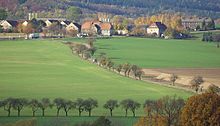Eiserode
|
Eiserode
City of Löbau
Coordinates: 51 ° 7 ′ 25 ″ N , 14 ° 37 ′ 30 ″ E
|
|
|---|---|
| Height : | 314 m |
| Incorporation : | January 1, 1994 |
| Postal code : | 02708 |
| Area code : | 03585 |
|
Location of Eiserode in the area of the city of Löbau
|
|
Eiserode ( Upper Sorbian ) is a district of the Saxon town of Löbau in the district of Görlitz .
location
The place is located five kilometers northwest of Löbau at 315 meters above sea level. Immediately north of Eiserode rises the Pfaffenberg (336 m), over whose summit the federal highway 6 leads. The multi-lane ascent of the trunk road, which leads straight across the mountain from Löbau to Bautzen from the valley of the buttermilk water near Nechen, often becomes an obstacle for heavy trucks in the winter months.
history
The square village was probably created during colonization by German farmers, but its shape is reminiscent of a Slavic round . As Ysinrode , it has been documented for the first time since 1354, when Otto von Luttitz left the interest income of the village to the St. Marienstern monastery . This made Eiserode a monastic exclave between the Bautzner Land and the property . For the year 1380 there are 12 farmers. The place was parish after Kittlitz . The town of Löbau held the jurisdiction of the higher courts for the place within its soft area. The residents mainly operated agriculture, which was quite profitable because of the loess loam soil.
A forge and inn were built directly on the Chaussee . This was acquired in 1880 by Johann Mickan, who had lived successfully as a sheep farmer in Argentina for many years, and named it Buenos Aires . The popular restaurant existed as a family business until the end of the 20th century and was then closed due to dilapidation.
The Löbauer dialect of Sorbian was spoken in Eiserode until the second half of the 20th century . Arnošt Muka determined a population of 166 in 1884/85, including 141 Sorbs (85%) and 25 Germans. In 1956, according to Ernst Tschernik , the Sorbian-speaking population was only 8.1% or a total of 23 speakers.
In 1960 a waterworks was built on the Pfaffenberg to supply the Sdier waterworks overland . During the GDR era, a cattle barn was built to the west of the village, to which a pig fattening system was added in 1971 near Peschen. In 1964 the trunk road on the "Eiseroder Berg" was widened, which was expanded again in the 1990s.
The districts of Nechen and Peschen belonged to Eiserode. On January 1, 1994 it was incorporated into Löbau.
Individual evidence
- ↑ Ernst Tschernik: The development of the Sorbian population . Akademie-Verlag, Berlin 1954.
- ^ Ludwig Elle: Language policy in the Lausitz . Domowina-Verlag, Bautzen 1995, p. 253 .
- ↑ Municipalities 1994 and their changes since January 1, 1948 in the new federal states , Metzler-Poeschel publishing house, Stuttgart, 1995, ISBN 3-8246-0321-7 , publisher: Federal Statistical Office
Web links
- Information about Eiserode on the website of the city of Löbau
- Photos from Eiserode
- Eiserode in the Digital Historical Directory of Saxony



